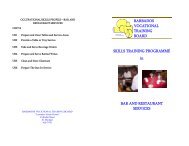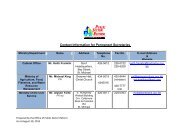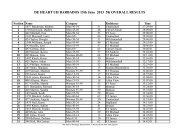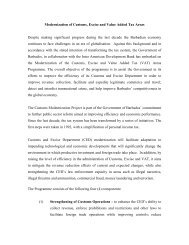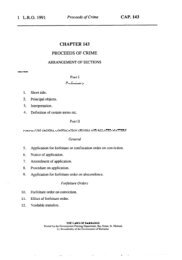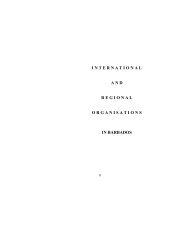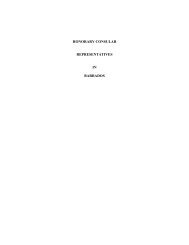The 2008 Agricultural Digest - Ministry of Agriculture and Rural ...
The 2008 Agricultural Digest - Ministry of Agriculture and Rural ...
The 2008 Agricultural Digest - Ministry of Agriculture and Rural ...
- No tags were found...
Create successful ePaper yourself
Turn your PDF publications into a flip-book with our unique Google optimized e-Paper software.
II. LITERATURE REVIEW ON AGRICULTUREAND ITS ROLE IN ECONOMIC DEVELOPMENTStructural change can be referred to as the long-term changein the fundamental structure <strong>of</strong> an economy throughout itsdevelopmental experience. Classical economists such asFisher (1939), Clark (1940), <strong>and</strong> Chenery <strong>and</strong> Syrquin (1975),highlighted the positive relationship between structural change<strong>and</strong> economic growth. For these economists, structuralchange referred to production shifting from the primary(agriculture, fishing, forestry, <strong>and</strong> mining) to the secondary(manufacturing <strong>and</strong> construction) <strong>and</strong> finally the tertiaryindustry (services).Kuznets (1961, 1971) in his empirical analysis <strong>of</strong> the theory<strong>of</strong> economic growth, disaggregated the economy into theclassifications <strong>of</strong> agriculture, industry <strong>and</strong> services. He foundan association between growth <strong>of</strong> per capita income <strong>and</strong> ashift in production structure (structural change). According to him,the relationship was established due to the combined effect <strong>of</strong>changes in the (i) structure <strong>of</strong> consumer dem<strong>and</strong>, (ii) comparativeadvantage <strong>and</strong> (iii) technology (Nayak <strong>and</strong> Mishra, 2009).Developmental economics was also highly influenced byLewis (1954). Lewis (1954) sought to explain the dynamics <strong>of</strong> howstructural transformation from an agricultural-based economyto a more industrial system would result in economic growth<strong>and</strong> development. Essentially, Lewis (1954) argued that theeconomy was dualistic, that is, divided into the traditional <strong>and</strong>capitalist sectors.His theory highlighted the fact that the traditional sectorexhibited low productivity, low technology, <strong>and</strong> those whoresided in rural areas produced most <strong>of</strong> what they consumed.However, the capitalist sector was pr<strong>of</strong>it-oriented, morecapital intensive, exhibited high productivity, was technologicallydriven <strong>and</strong> paid higher wages than the traditionalsector. According to Eicher <strong>and</strong> Staatz (1998), the relative neglect<strong>of</strong> the agricultural industry during the 1950s was furtherexacerbated by the two independent theses <strong>of</strong> Raul Prebisch<strong>and</strong> Hans Singer in 1949, <strong>and</strong> Hirschman in 1958. Prebisch <strong>and</strong>Singer both argued that over time, the terms <strong>of</strong> trade would beagainst those countries that exported primary products <strong>and</strong>imported manufactured ones. Hirschman (1958) on the otherh<strong>and</strong> introduced the concept <strong>of</strong> linkages as a tool for investing.He suggested that investing in one type <strong>of</strong> activity inducesinvestment in other income-generating activities. Accordingto Hirschman (1958), investment in industry would generallylead to a more rapid <strong>and</strong> broad-based economic growth thaninvestment in agriculture would.<strong>The</strong>se aforementioned classical theories that placed agriculturein a secondary role essentially overshadowed the works <strong>of</strong>other economists who attempted to illustrate the industry ina positive light. Kuznets (1961) was one <strong>of</strong> these economiststhat acknowledged the positive contributions <strong>of</strong> the agriculturalindustry to economic growth, in such areas as product, market<strong>and</strong> factor development in the economy.Johnston <strong>and</strong> Mellor (1961) also supported Kuznets (1961)by arguing that agriculture could play a far from passive roleby making five important contributions in the growth <strong>and</strong>development <strong>of</strong> developing economies. <strong>The</strong>se contributionsinclude: increasing national food supplies; providing labourfor other industries; capital formation; the earning <strong>of</strong> foreignexchange; <strong>and</strong> the stimulation <strong>of</strong> industrialisation throughincreased rural net cash income.Volume 1<strong>Agricultural</strong> <strong>Digest</strong> | <strong>2008</strong>5



